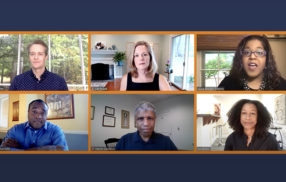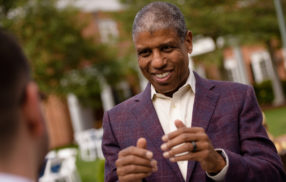
You’ve Assembled a Diverse Team. Now, How Do You Make It High-Performing?
By Seb Murray
Global protests after the killing of George Floyd in May 2020 sparked a surge in calls for racial justice and equity, led and intensified by the Black Lives Matter movement. Many businesses responded by making public commitments to numerous dimensions of diversity, including race and ethnicity, gender balance, all forms of sexual orientation, disability and age.
Many institutions view diversity as a moral imperative. As the evidence builds that diversity also boosts performance, managers face a paradox: While varied perspectives add value, they often cause friction. So it takes enlightened leadership — with high emotional intelligence, compassion and humility — to motivate, integrate and coordinate teams, according to a pair of Darden professors with expertise in building high-performing teams that maximize the benefits of diversity.
“Diversity enhances work output, but people often report having a less positive experience in diverse teams because of conflict,” says Professor Laura Morgan Roberts, noting this can lower motivation and productivity and increase employee turnover.
Her research focuses on the science of maximizing human potential in diverse organizations. She says it’s not as simple as recruiting at random as many people with different perspectives and backgrounds as possible. Building diverse teams requires more intentionality.
Identify Existing Inequalities and Address Them
Teams need a critical mass of minority perspectives for mixed teams to outperform.
“Leaders need clarity over what dimensions of diversity are meaningful and significant for their organization,” Roberts says.
Diversity Is More Nuanced Than Protected Characteristics Such as Gender or Race
Managers often struggle to gauge diversity accurately, Roberts says, including how different aspects of difference combine to shape individual identity. “For example, I’m a Black woman, a business professor and a psychologist. These overlapping factors shape my perspectives and how I contribute to my organization.”
Companies That Select Teams Based on One Characteristic Risk Claims of Tokenism
Professor Lynn Isabella urges companies to look beyond simplistic definitions of diversity to unearth hidden talents. “It’s often the person that you never expect who has something unique to offer the team,” she says, stressing the importance of looking for cognitive differences, not just tangible diversity.
When businesses hire based on a single, tangible element of diversity, Roberts says “people won’t feel they can bring their whole selves to work. They won’t feel welcome or that their contributions are valued.”
Conflict Is Inevitable but It Can Improve Performance
“Many of us go into a team and do the same thing we’ve always done,” Isabella says. “But a diverse team gives you the space and freedom to try something different, learn a new skill, take on a new challenge and grow.”
Isabella recommends looking for people who want to collaborate, even if it means sacrificing a strong performer for the good of the wider team. The tendency is for team leaders to choose proven performers because of time pressures, but that often rules out diverse talent because minorities may have less opportunity to showcase their talents, she adds. Instead, team leaders need to take chances on newcomers to achieve a broader representation and superior results.
Diverse Teams Outperform the Less Diverse in Many (Not All) Circumstances
Indeed, Roberts says research has proven that mixed teams outperform in many circumstances, for example when they need to tap similarly diverse consumer markets, perform collective problem-solving or catalyze innovation.
That said, diverse teams do not always work better than homogenous groups. Studies show that teams from similar backgrounds outperform at executing existing solutions, Roberts says.
Managers Can Stifle the Benefits of Diverse Teams
The innovative ideas of diverse teams can be stifled by decision-makers higher up the company, where diversity tends to taper off. Indeed, many companies focus too heavily on recruiting diverse talent and not enough on inclusion and leadership development, says Roberts. This often leads to minorities who do not speak out on teams.
“You need to create a context in which people from diverse backgrounds can grow, thrive and contribute,” she says, including by rooting out unconscious bias and championing mentorship.
Above All, Managers Must Look Within
Roberts notes that managers often shy away from conflict and can become defensive. “They may recognize the value of diversity, but they also struggle with being in environments where people are questioning their decisions.”
Managing mixed teams therefore requires humility, she says. “We must acknowledge and admit our way is not the only or the best way. Even if something works really well for us, that doesn’t mean it’s going to work equally well for others,” Roberts says. The best leaders are curious, too, and take a genuine interest in their employees. “It’s so important in diverse organizations that people keep learning.”
It may not be easy, but self-reflection, nurturing curiosity and humility, taking a broader view of diversity, aligning teams with the right tasks, and addressing wider inequalities are well worth doing, says Isabella.
“That doesn’t mean the team will be plain sailing. There will be bumps along the road, but the potential for an incredible result at the end is huge.”
The University of Virginia Darden School of Business prepares responsible global leaders through unparalleled transformational learning experiences. Darden’s graduate degree programs (MBA, MSBA and Ph.D.) and Executive Education & Lifelong Learning programs offered by the Darden School Foundation set the stage for a lifetime of career advancement and impact. Darden’s top-ranked faculty, renowned for teaching excellence, inspires and shapes modern business leadership worldwide through research, thought leadership and business publishing. Darden has Grounds in Charlottesville, Virginia, and the Washington, D.C., area and a global community that includes 18,000 alumni in 90 countries. Darden was established in 1955 at the University of Virginia, a top public university founded by Thomas Jefferson in 1819 in Charlottesville, Virginia.
Press Contact
Molly Mitchell
Senior Associate Director, Editorial and Media Relations
Darden School of Business
University of Virginia
MitchellM@darden.virginia.edu







